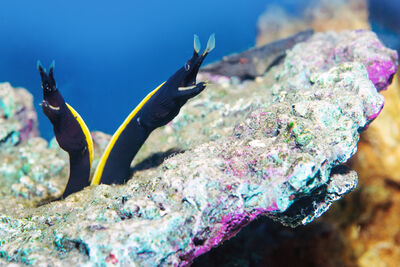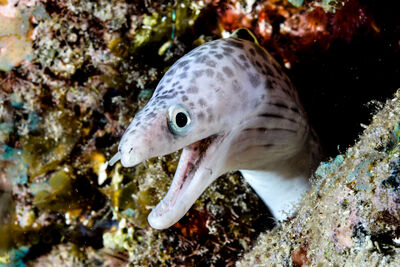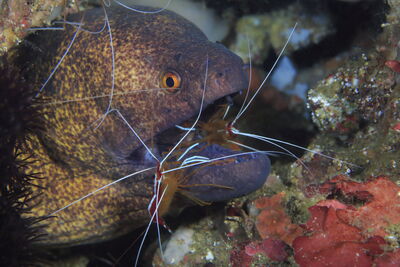Snake-like eels definitely aren't winning in the beauty department. Yet these slender, toothy creatures beguile divers and scientists alike with their mysterious behaviour. While eels been on Earth for millions of years, little is known about these elusive creatures, such as where freshwater eels spawn and the full reproductive cycles of wild eels. But all is not lost, as there is a fair amount we do know. For starters, all eels undergo a leptocephalus stage, where they spend an extended amount of time as flat, transparent larvae in the open ocean. They also know the value of teamwork (more on that later). If you too are fascinated with the secret lives of eels, read on to discover our top ten eel facts.

1. There Are Hundreds of Eel Species
There are more than 800 species of eel, spanning eight suborders, 19 families and 111 genera, however, all eels belong to the order Anguilliformes.
Eels are a diverse group that range in habitat, size and colour. From the deep-sea dwelling bobtail eel (Cyema atrum) that grows up to four inches, to the honeycomb moray eel (Gymnothorax favagineus), a vibrant yellow and black spotted eel that grows as long as six feet, there are eels scattered across the globe.
2. Moray Eels Have Mutualistic Relationships
As opportunistic, carnivorous predators, moray eels feed on crustaceans, small fish, and octopuses. That being said, they also value personal hygiene. To combat parasites, moray eels have formed a mutualistic relationship with cleaner shrimps. Moray eels allow cleaner shrimps to give their eyes, teeth and gills a good clean, and in return, the cleaner shrimp gets a free meal.

3. Moray Eels and Groupers Hunt Together
Moray eels aren't in an exclusive mutualistic relationship and will partner with various species for different purposes. Take giant moray eels (Gymnothorax javanicus) and groupers (Plectropomus pessuliferus). In 2006, researchers in the Red Sea, Egypt, described coordinated hunting between the two species.
The study observed groupers shaking their head to moray eels, signalling it was time to hunt. In response, the moray eels would leave their resting place to join the grouper.
The hunt involved groupers, which hunt during the day, leading the eels to prey hiding in the reef. The eels would then scour the cracks and crevices to flush out escaping prey.
While groupers and eels might seem like an unlikely duo, combining these two different hunting strategies led to greater success.
4. Electric Eels Aren’t Eels
Despite their name, electric eels, with their ability to produce a shock as strong as 650 volts, aren't true eels. True eels, as we mentioned earlier, belong to the order Anguilliformes, while electric eels are members of the order Gymnotiformes. They aren't even closely related. Despite looking quite similar, electric eels are more closely related to carp and catfish than eels.

5. Most Eels Have Poor Eyesight
Despite being top predators, many eels, including moray eels, have astonishingly poor eyesight. Luckily, they make up for it with their nocturnal lifestyle and a keen sense of smell.
Next time you find yourself diving in the company of a moray eel, look closely (but not too closely) at their nose and you might be able to spot their prominent nostrils. A moray eel's sense of smell is superior to most fish species, enabling them to sniff out dead, wounded and sick prey, which makes for easy hunting. This means they're a key species in reefs as they help to weed out sick, wounded and dead animals.
6. The Great Migration of Some Species of Eel
For years, eel migration was a big mystery to scientists. But in 2022, satellite tags confirmed that European eels undertake an epic journey to the Sargasso Sea in the Atlantic to breed. They do this once in their lifetime before they die.
The new generation of eels then spend between two to three years drifting in the Atlantic before ending up in European rivers where they adapt to freshwater and mature. American eels also undertake a similar journey.

7. One Eel Can Hunt in the Open Air
One of our favourite eel facts is that the snowflake moray eel (Echidna nebulosa) has demonstrated the ability to ambush unsuspecting crabs… on land. Researchers observed these incredible creatures wriggling out of the sea and onto land to hunt and consume their prey.
8. In Some Countries Eel Meat Is a Delicacy
Fans of Japanese cuisine might be familiar with this eel fact, as eel meat is hugely popular in Japan. Unagi Don, a popular summertime meal in Japan, is typically made of grilled Japanese eel (Anguilla japonica) served with a sweet sticky sauce on top of a bed of white rice. Unagi, Japanese for eel, is said to have a sweet and slightly fishy taste.

9. Moray Eels Have Two Jaws
There are roughly 200 species of moray eels, all of which belong to the Muraenidae family. They are almost exclusively marine species, although a handful live in freshwater.
Moray eels are carnivores and have two sets of jaws. They've got their primary jaws, which they use to capture prey, and then they're got pharyngeal jaws, a smaller set of jaws in their throat. This second set helps to pull resistant prey back down into their throat and their digestive tract.
10. Ancient Romans Kept Moray Eels
Records from Ancient Rome show that the Roman aristocracy kept well-stocked fishponds, some of which contained moray eels. The purpose of these ponds was to maintain a fresh supply of fresh fish and eels.
However, the Romans were well aware of the predatory nature of moray eels, and one author (Columella c.4 - c. 70 CE), advised keeping the eels in a separate pond to avoid casualties.












